Source: News 10 NBC
Date: April 16, 2025
GENEVA, N.Y. – The Trump administration’s efforts to cut expenses have led to the cancellation of hundreds of federal leases, including one in Ontario County. This lease termination affects a federal agency responsible for miner safety, raising concerns about the future of inspections in the region.
Shane Chiappone, a miner at American Rock Salt, emphasized the importance of regular inspections.
Chiappone serves as the president of the United Steel Workers Local 763, the union that represents roughly 250 employees at American Rock Salt, so he recognizes the value in having independent inspectors visit the mine on a regular basis.
“It’s very important. It’s important for all of us who work there, union and non-union,” said Chiappone.
The Department of Government Efficiency, (DOGE) led by Elon Musk, has terminated 653 federal leases, saving $350 million. This includes the Geneva field office of the Mining Safety and Health Administration (MSHA), which had an annual lease of $52,000.
Erin Bates, spokesperson for the United Mine Workers of America, expressed concern.
“It’s concerning to the miners that are working day in and day out in a very dangerous job to not have the mine inspectors in a close distance from their mine sites,” said Bates.
The Geneva office, one of only two in New York, has been home to nearly a dozen inspectors for over 20 years. Matthew DiDuro, the building’s landlord, confirmed the lease termination.
“They sent us a note saying that our lease would be terminated as of September 30 of this year,” said DiDuro.
What is still unclear is whether inspectors’ jobs would be moved to other offices or eliminated entirely.
“In this case, yeah, we lost our lease – or we’re going to, but more importantly, I get concerned about these agents and if they’re going to lose their jobs as well,” said DiDuro.
The Department of Labor did not clarify the inspectors’ fate but in a statement said:
“Mine Safety and Health Administration inspectors continue to conduct legally required inspections and remain focused on MSHA’s core mission to prevent death, illness, and injury from mining and promote safe and healthful workplaces for U.S. miners.”
Bates highlighted the lack of communication. “We don’t know if these inspectors are losing their jobs and there’s going to be job losses or if they’re just going to be relocated,” said Bates.
Chiappone says despite the cuts, he believes as long as there are mines, MSHA will have some form of presence.
“Whether or not they have to travel a little further to get to and from the mine, wherever their new office is going to be, I hope it doesn’t have any effect on us,” said Chiappone.
The Albany office’s lease has also been terminated, leaving the nearest location in Warrendale, Pennsylvania, about 270 miles away.
Written by: Brett Davidsen





